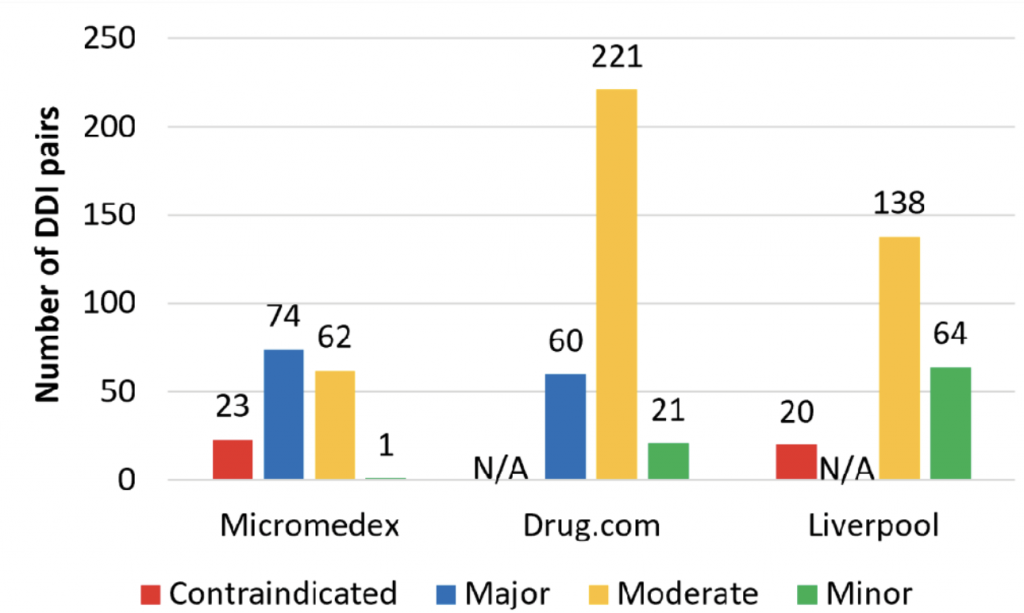Highlight
แพทย์ เภสัชกรและผู้ให้บริการด้านสุขภาพควรตรวจสอบ การเกิดปฏิกิริยาระหว่างยากับยา (drug-drug interaction) เพื่อความปลอดภัยของผู้ป่วย และเพื่อประสิทธิภาพของการรักษาโรค HIV

ที่มาและความสำคัญ
การติดเชื้อ HIV ถือเป็นภาวะที่คุกคามถึงชีวิต ผู้ติดเชื้อ HIV มีอัตราการเจ็บป่วยร่วมสูง เช่น โรคหลอดเลือดหัวใจ มะเร็ง เบาหวาน โรคไขมันในเลือดผิดปกติ โรคไตเรื้อรัง และโรคตับเรื้อรัง ดังนั้น จึงต้องมีจ่ายยาเพื่อรักษาโรคเหล่านี้ร่วมกับการใช้ยาต้านไวรัส ดังนั้น ผู้ป่วย HIV จึงมีความเสี่ยงต่อการเกิดปฏิกิริยาระหว่างยากับยา (drug-drug interaction หรือ DDI ) มากกว่าผู้ป่วยกลุ่มอื่น จุดประสงค์ของงานวิจัยนี้คือเพื่อประเมินระดับของความสอดคล้องกัน (level of agreement) ของ DDI ของยาต้านไวรัส 17 ชนิด และยาอื่น ๆ อีก 92 ชนิดที่มีการจ่ายบ่อยครั้งในผู้ติดเชื้อ HIV ด้วยฐานข้อมูล 3 แหล่ง ได้แก่ Micromedex Drugs.com และ Liverpool ผลการวิจัยพบว่าฐานข้อมูลทั้งสามตรวจพบ DDI ที่เป็นไปได้ทั้งสิ้นรวมกัน 383 คู่
Abstract
Background: Since the advent of antiretroviral therapy, HIV infection, which was once considered a life-threatening condition, can now be managed as a chronic disease. People infected with HIV have high prevalence rates of comorbid illnesses, including cardiovascular diseases, cancers, diabetes, dyslipidemia, chronic renal disease, and chronic liver disease. Comedication of antiretrovirals and frequently prescribed medications for comorbid illness could cause serious drug-drug interactions (DDIs). Objective: To evaluate the level of agreement among the drug interaction tools of three databases (Micromedex, Drugs.com, and Liverpool HIV Drug Interactions Checker) for potential DDIs detection. Methods: Drugs were selected from National List of Essential Medicines of Thailand (2021) and the Ramadhibodi Chakri Naruebodindra Hospital drug list. Potential DDIs were identified by the three databases. The agreement was determined by Fleiss’ kappa. Results: Seventeen antiretrovirals and 77 frequently prescribed medications from the National List of Essential Medicines of Thailand (2021) and the Ramadhibodi Chakri Naruebodindra Hospital drug list were included in this study. Overall, 383 pairs of potential DDIs were detected by the three databases. Drugs.com reported the highest number of DDIs (302 pairs), followed by the Liverpool (222 pairs) and Micromedex (160 pairs) databases. Among these DDIs, 113 pairs (29.5%) were reported as contraindicated or major severity in all three databases. The major DDI mechanisms were pharmacokinetic-based cytochrome P450 inhibition (33.4%) and induction (20.1%). Fleiss’ kappa agreements were slightly concordant among the three databases (0.0476). Conclusions: Healthcare provider vigilance is important to manage the potentially varying DDI information in different databases that could impact the safety and efficacy of HIV treatment.
KEYWORDS: drug interactions, antiretrovirals, metabolic syndrome, micromedex, drugs.com, liverpool HIV drug interactions checker
Citation: Jiso, A., Thiengtham, K., Suwannakhan, A., Sirijaraswan, N., Khemawoot, P., & Sungkanuparph, S. (2024). Antiretrovirals and frequently prescribed medications in people living with HIV: Potential drug-drug interactions detected by three online-databases. Pharmacy Practice, 22(2), 1-14.
Available from: https://www.pharmacypractice.org/index.php/pp/article/view/2940
RELATED SDGs:
3. GOOD HEALTH AND WELL-BEING

ผู้ให้ข้อมูล: ผู้ช่วยศาสตราจารย์ ดร.อธิคุณ สุวรรณขันธ์
ชื่ออาจารย์ที่ทำวิจัย: ผู้ช่วยศาสตราจารย์ ดร.อธิคุณ สุวรรณขันธ์
Credit ภาพ: ผู้ช่วยศาสตราจารย์ ดร.อธิคุณ สุวรรณขันธ์
Webmaster: ว่าที่ ร.อ. นเรศ จันทรังสิกุล
Tags: antiretrovirals, drug interactions, drugs.com, liverpool HIV drug interactions checker, metabolic syndrome, micromedex
